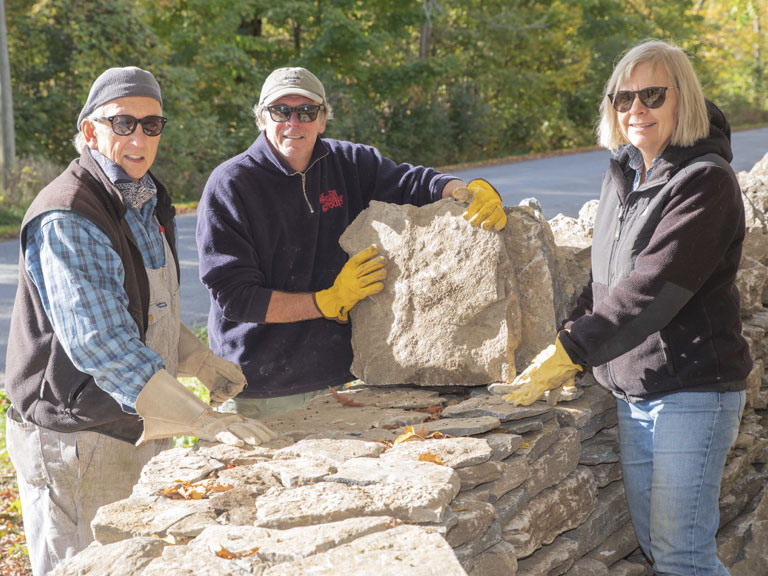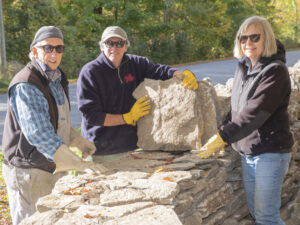County News
Building walls

Morrison Point Road neighbours rebuild dry stone walls
About seven or eight years ago Morrison Point Road resident Les Stanfield and his son rebuilt the dry stone wall at the front of his property. Later that year, Stanfield and his wife, Anne Dumbrille, attended a dry stone wall celebration on Amherst Island where he met representatives from Dry Stone Wall Canada and asked if he could arrange for a course on how to rebuild dry stone walls on Morrison Point Road. He canvassed his neighbours, and the course took place, kicking off a multi-year project to rebuild the walls along the roadway. While there are dry stone walls all over the County—the abundance of stony fields providing plenty of raw materials—Morrison Point Road is unique for the number of such walls along its length. “We saw the walls on the road and realized they were part of our heritage, and they were falling down and we just wanted to fix them,” said Stanfield. Many of these walls are over a century old and have fallen into disrepair. Some walls were actually torn down and used as backfill for road construction. Others have succumbed to the ravages of time and weather. Tree roots will destabilize a wall, and the freeze-thaw cycle will cause the stones to shift, eventually leading to collapse of the wall.

(L-R): Brian O’Donnell, Howard Scott and Anne Dumbrille lay a capstone on a new section of dry stone wall along Morrison Point Road.
It is a long and slow process to rebuild a wall, particularly if the base is unstable. That means all of the stones have to be removed and the entire wall rebuilt. When the Morrison Point Road project started four years ago, the technique was first to lay down and eight inch thick layer of gravel as a base and building up from there. The stone walls are typically 36 to 40 inches high and about 36 inches wide at the base, tapering to 30 inches at the top. Vertical capstones are used to pin the top layer of stones in place. Rebuilding a fallen dry stone wall requires there is sufficient material at hand, but replacing one that has been removed means seeking out a supply of stones. There are plenty in neighbouring fields, but they have to be painstakingly dug up. Fortunately the group was able to obtain a supply from the excavation at a new build along the road. Two years ago, the group got access to a backhoe, which significantly eased the drudgery of dragging stones from one place to another. They were also able to modify their construction technique. “We now have backhoes to lay great big slabs of limestone at the base and then building on top of that. We think the wall would be much more stable,” said Stanfield.
In their first two years, the group restored about 30 feet of wall each year, generally spending a couple of hours one day a week through summer and early autumn. This year they met twice a week and built about 50 feet of new wall at the old schoolhouse, and rebuilt about 30 feet at another location. Last Saturday, they celebrated the end of this season with a final build at the schoolhouse followed by a barbeque. “It’s a lot of fun. It’s like building a jigsaw puzzle, but you get some exercise. There’s a lot of camaraderie and good community spirit,” said Stanfield. For more information about the Morrison Point Road Dry Stone Wall Project, please visit morrisonpointstonewall.ca

Comments (0)